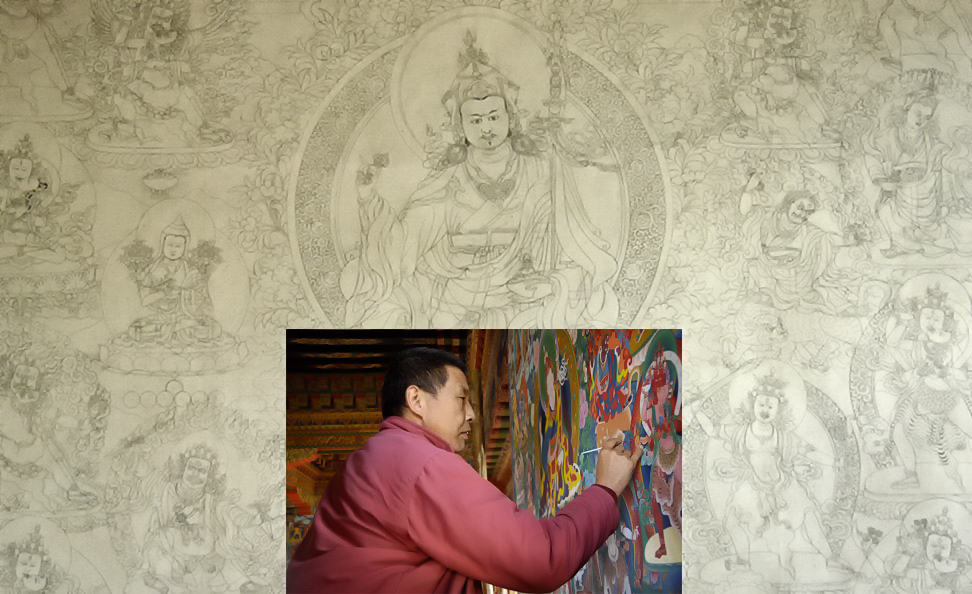Handmade: Thangka Painting
The history of Thangka painting goes back to a style of religious art originating in India, where Buddhism began more than two thousand years ago. As Buddhism gradually moved to Tibet, Tibetan painting began to evolve its own style. As a natural extension, Bhutan developed a truly Bhutanese style of Thangka. The complex or intricate thangkas serve many purposes: religious mantras for monks in meditation, to commemorate special events, to illustrate religious calendars. Others focus on the lives of famous spiritual or historical figures.
The many different types of Thangkas, embroidered, woven, appliquéd, or in this case painted, are all designed to be easily rolled up and carried on journeys, and were complete with silk or brocade dust covers to keep them clean when not in use.
Centuries Old Process: Muslin or canvas is tautly stretched to avoid wrinkles in the drawing and painting of the canvas, after which bamboo poles are secured on each of the four sides. Then the canvas is prepared by applying yak skin glue to the front and back, after which a thin film of white paint or distemper (paint with glue) is applied all over the surface. The canvas is left in the sun to dry. Later the artist uses a river pebble, or in some cases a jade stone, to rub the canvas repeatedly to smooth the surface. If prepared properly a canvas should be soft, like a well-tanned goatskin.
Note: The fresco medium is a lost art in Bhutan (17th century). Monastery (thangka) wall painting is done on canvas applied (animal skin glue) directly to the monastery wall, then drawn and painted in the traditional thangka technique. See photo above.
After the canvas is prepared, the artist draws his figures using a charcoal pencil, which is made from burned willow trees. Thangka painting is not creative. The images are drawn and painted according to written guidelines, and traditional proportions and figures are not subject to artistic whim. The figures are sketched exactingly, using only 8 prescribed lines. Only when the figure is placed on the canvas according to the rules, can painting begin.
According to the "Manual for Traditional Painting" (Trashiyangtse Institute for Zorig Chusum, 2004) the artist "Using brushes made of the hair [from] within the ears and in the mane of the cow, [found] during the 3rd and 4th month of the lunar calendar year", paints the figures of religious figures on the thangkas. "Yellow, black, and red are sourced from minerals, mixed with water, then further mixed with other colors to produce a wide range of hues. Often mineral colors are mixed with colors extracted from trees, especially the symplocos, which produces a yellow dye.
Painters can also use lac, a noble red made from the excretions of a scale insect.
Personal Note from Kathleen Fung: Lac dye is one of the most amazing color processes I have observed in my travels to Bhutan. While on a study trip to eastern Bhutan with textile-dyeing expert Dr. Jenny Balfour Paul, we observed the tiny scale insect (Kerria chinensis), as identified by Dr. Jenny Balfour Paul, on an Indian jujube tree. (Chasing the lac insect in the Land of the Thunder Dragon, Geographical Magazine, April 2005). The insects essentially feed on the sap of the host tree, secreting a protective coating covering the colony as well as the twigs and branches of the tree. Later this hard encrusted shell is scraped off, then pounded into small pieces, and boiled in a large vat of water to yield the gorgeous blood red dye; after filtering all the lac dye, the remaining wax-like resin is shaped into thick brown sticks for sealing wax (stick lac) and shellac.
Few Bhutanese engage in lac cultivation now as it is believed that the tiny insects are killed in the process, which goes against Buddhist law. So this precious noble red, used in Thangka painting and for weaving the special ghos and sacred scarves for the monk body, may vanish in the very near future.
The final and very important step involves painting with gold, using costly gold tablets brought from Nepal. A starch made from a cereal grain called zarma is mixed with pure gold tablets, usually imported from Nepal. After applying the gold touches to the canvas, the painter then rubs the piece with an onyx stone.
Bhutan Thangka Traditional Painting (Source: Research gathered by Kathleen Fung in November 2004, while visiting the Trashi Yangtse Institute for Zorig Chusum, Lam Kezang, Director. Kathleen Fung met with the masters of this style of Thangka painting, which they still create in the time-honored way.)
|














